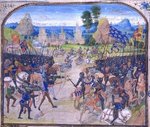GrauGeist
Generalfeldmarschall zur Luftschiff Abteilung
Perhaps one thing that many people overlook, is the fact that to be a European Knight, one had to train for years. A student usually became esquired to a Knight, and was tutored in battle techniques and trained constantly. Once his mentor thought him ready, he then had to prove his prowess, usually in contests during festivals. The time period could be about 8 - 10 years to become elligable for Knighthood, and not everyone would qualify.
This wouldn't make for good movie material, so people are usually left with the impression that to be a Knight, you have to save everyone in some climactic battle, and the King himself comes over and Knights you on the spot...
To be Samurai, you had a similiar scenario. A student would be taken under the tutelage of a "Sensei" who was a master of the art. The student would then be trained in the arts, much like his European counterpart, for years. Not everyone would qualify to be a Samurai, either.
I think that a classic battlefeild confrontation between the Knights and Samurai from comparable time periods would be a clash of the Titans.
The typical sword of the Knight would definately be an advantage, and tear into the Samurai's lighter armor, but if the Knight did not carry the battle in a short time period, I think that the Samurai would take a victory by wearing the Knight down. A Samurai is incredibly skilled in blow and thrust placement of thier sword, and would use that accuracy to thier advantage, as well.
The Portuguese soldiers were able to defeat Samurai with thier Rapiers not because it would cleave the Samurai's armor, but because in a thrust, it would penetrate in between the laquered iron shingles of the Samurai's armor.
The rapier also flexed when parrying a blow from a katana, and allowed the Portuguese soldier the ability to return a thrust to his enemy faster, and speed is your best defense against a Samurai.
All in all, I would say it's a draw.
By the way, the typical men of the middle ages stood about 5 foot, 6 inches on average. King Richard (the Lionheart) was referred to as "A giant among men" with his almost 6 1/2 foot stature.
This wouldn't make for good movie material, so people are usually left with the impression that to be a Knight, you have to save everyone in some climactic battle, and the King himself comes over and Knights you on the spot...
To be Samurai, you had a similiar scenario. A student would be taken under the tutelage of a "Sensei" who was a master of the art. The student would then be trained in the arts, much like his European counterpart, for years. Not everyone would qualify to be a Samurai, either.
I think that a classic battlefeild confrontation between the Knights and Samurai from comparable time periods would be a clash of the Titans.
The typical sword of the Knight would definately be an advantage, and tear into the Samurai's lighter armor, but if the Knight did not carry the battle in a short time period, I think that the Samurai would take a victory by wearing the Knight down. A Samurai is incredibly skilled in blow and thrust placement of thier sword, and would use that accuracy to thier advantage, as well.
The Portuguese soldiers were able to defeat Samurai with thier Rapiers not because it would cleave the Samurai's armor, but because in a thrust, it would penetrate in between the laquered iron shingles of the Samurai's armor.
The rapier also flexed when parrying a blow from a katana, and allowed the Portuguese soldier the ability to return a thrust to his enemy faster, and speed is your best defense against a Samurai.
All in all, I would say it's a draw.
By the way, the typical men of the middle ages stood about 5 foot, 6 inches on average. King Richard (the Lionheart) was referred to as "A giant among men" with his almost 6 1/2 foot stature.

